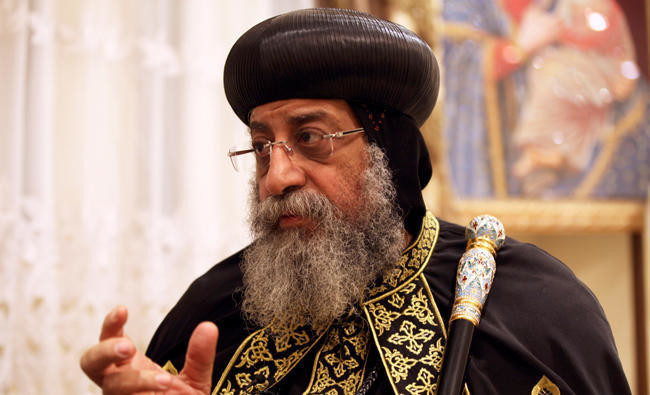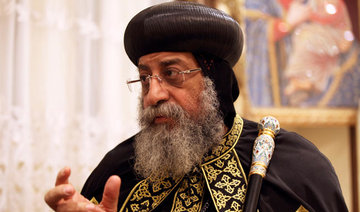CAIRO: Egypt’s Coptic Orthodox Church announced its unremitting support for a new counter-terrorism operation by the Egyptian military and police to defeat terrorism across the country.
“History will record the sacrifices of our courageous police and Armed Forces with letters of light ... Long live Egypt’s unity” read the statement of the Orthodox Church.
The statement said the church, headed by Pope Tawadros II, declares its solidarity and support for the “comprehensive battle” aimed at purging “the forces of terrorism” across the nation.
Similarly, Al-Azhar Institute, Egypt’s top Islamic authority, expressed its full support for the “Comprehensive Operation Sinai 2018” announced by the armed forces and the Ministry of the Interior on Friday.
The operation will be carried out in north and central Sinai, as well as other parts of the country.
Coptic church backs Egypt counter-terrorism operation
Coptic church backs Egypt counter-terrorism operation

Lull in Gaza fighting as Biden urges truce in Eid message

In a holiday message late Sunday, US President Joe Biden called for the implementation of a ceasefire plan he outlined last month, saying it was “the best way to end the violence in Gaza” and to help civilians suffering “the horrors of the war between Hamas and Israel.”
A daytime “pause” for aid deliveries announced at the weekend by Israel’s military around a southern Gaza route appeared to be holding, while elsewhere in the Palestinian territory an AFP correspondent said strikes and shelling have decreased.
In Gaza City, medics at Al-Ahli hospital said at least five people were killed in two separate air strikes, and witnesses reported tank shelling in the southern neighborhood of Zeitun.
At least one strike hit Bureij refugee camp in the central Gaza Strip, residents said.
Palestinian officials in the far-southern city of Rafah reported tank shelling early on Monday, before the start of the daily “local, tactical pause of military activity” announced by the army.
It said the pause “for humanitarian purposes will take place from 8:00 am (0500 GMT) until 7:00 p.m. (1600 GMT) every day until further notice along the road that leads from the Kerem Shalom crossing to the Salah Al-Din road and then northwards.”
An Israeli official, speaking on condition of anonymity, told AFP “there was no change” in the military’s policy and stressed fighting “continues as planned.”
An army spokeperson told AFP the pause was in effect on Monday, and the military in a statement said troops were still operating in Rafah and central Gaza, reporting “close-quarters combat” that killed several militants.
Witnesses told AFP they could hear blasts in Rafah’s city center and west on Monday morning.
A map released by the army showed the declared humanitarian route extending up to Rafah’s European Hospital, about 10 kilometers (six miles) from Kerem Shalom.
Mahmud Basal, spokesman for the civil defense agency in the Hamas-ruled territory, said that apart from the deadly Gaza City strikes overnight, “the other areas of the Gaza Strip are somewhat calm.”
He reported military movements and gunfire in parts of Rafah as well as Bureij camp in central Gaza.
On Sunday, the first day of Eid Al-Adha, or the feast of the sacrifice, the spokesman said “calm has prevailed across all of Gaza.”
The United Nations has welcomed the Israeli announcement of the pause, although “this has yet to translate into more aid reaching people in need,” said Jens Laerke, spokesman for the UN humanitarian agency OCHA.
He called for “further concrete measures by Israel to address longstanding issues” on humanitarian needs.
Gazans “urgently need food, water, sanitation, shelter, and health care, with many living near piles of solid waste, heightening health risks,” Laerke said.
Dire shortages of food and other essentials in the Gaza Strip have been exacerbated by overland access restrictions and the closure of the key Rafah crossing with Egypt since Israeli forces seized its Palestinian side in early May.
The military said the pause was in effect as part of efforts to “increase the volumes of humanitarian aid” following discussions with the United Nations and other organizations.
It was announced a day after eight Israeli soldiers were killed in a blast near Rafah and three more troops died elsewhere, in one of the heaviest losses for the army in more than eight months of war against Hamas militants.
The war was triggered by Hamas’s unprecedented October 7 attack on southern Israel that resulted in the deaths of 1,194 people, mostly civilians, according to an AFP tally based on Israeli official figures.
The militants also seized 251 hostages. Of these, 116 remain in Gaza, although the army says 41 are dead.
Israel’s retaliatory offensive aimed at wiping out Hamas has killed at least 37,337 people in Gaza, also mostly civilians, according to the territory’s health ministry.
Egyptian, Qatari and US mediators have been pushing for a new Gaza truce, so far without success.
Washington has been pressing Israel and Hamas to formally accept Biden’s truce plan, which would allow an initial six-week pause to fighting.
“I strongly believe that the three-phase ceasefire proposal Israel has made to Hamas and that the UN Security Council has endorsed is the best way to end the violence in Gaza and ultimately end the war,” the US president said.
The only previous truce lasted one week in November and saw many hostages released in exchange for Palestinian prisoners held in Israeli jails, while increased aid flowed into Gaza.
Hamas has insisted on the complete withdrawal of Israeli forces from Gaza and a permanent ceasefire — demands Israel has repeatedly rejected.
Netanyahu disbands his inner war cabinet, Israeli official says

- The prime minister had faced demands from the nationalist-religious partners in his coalition
JERUSALEM: Israeli Prime Minister Benjamin Netanyahu has dissolved the six-member war cabinet, an Israeli official said on Monday, in a widely expected move that came after the departure from government of the centrist former general Benny Gantz.
Netanyahu is now expected to hold consultations about the Gaza war with a small group of ministers, including Defense Minister Yoav Gallant and Strategic Affairs Minister Ron Dermer who had been in the war cabinet.
The prime minister had faced demands from the nationalist-religious partners in his coalition, Finance Minister Bezalel Smotrich and National Security Minister Itamar Ben-Gvir, to be included in the war cabinet, a move which would have intensified strains with international partners including the United States.
The forum was formed after Gantz joined Netanyahu in a national unity government at the start of the war in October and also included Gantz’s partner Gadi Eisenkot and Aryeh Deri, head of the religious party Shas, as observers.
Gantz and Eisenkot both left the government last week, over what they said was Netanyahu’s failure to form a strategy for the Gaza war.
KSrelief project removes more mines in Yemen

- The project removed 1,556 mines across Yemen
RIYADH: Masam, the mine-clearing project run by the Saudi aid agency KSrelief, removed and dismantled hundreds of landmines in Yemen during the second week of June, the Saudi Press Agency reported on Monday.
The project removed 1,556 mines across Yemen: 52 anti-tank mines, 1,503 items of unexploded ordnance, and one explosive device.
So far in June there have been 2,810 mines removed in Yemen, bringing to 447,668 the number of mines removed since Masam was launched.
Once fruitful, Libyan village suffers climate crisis

KABAW, Libya: In the Libyan village of Kabaw in the Nafusa Mountains, M’hamed Maakaf waters an ailing fig tree as climate change pushes villagers to forsake lands and livestock.
Once flourishing and known for its figs, olives, and almonds, fields around Kabaw, located some 200 kilometers (124 miles) southwest of Tripoli, are now mostly barren and battered by climate change-induced drought.
The area was once “green and prosperous until the beginning of the millennium,” Maakaf recalled. “People loved to come here and take walks but today it has become so dry that it’s unbearable.”
“We no longer see the green meadows we knew in the 1960s and ‘70s,” added the 65-year-old, wearing a traditional white tunic and sirwal trousers.
Kabaw, like many villages in the Nafusa Mountains, is primarily inhabited by Amazigh people, a non-Arab minority.

Pounded by the sun and dry winds, the mountainous area now struggles to bear fruit, facing a lack of rainfall and temperatures high above seasonal norms.
Libya — where around 95 percent of land is desert — is one of the world’s most water-scarce countries, according to the United Nations.
Its annual precipitation in coastal areas has fallen from 400 millimeters in 2019 to 200 millimeters today, with water demand higher than what is available.
The Nafusa Mountains, sitting at an altitude of almost 1,000 meters (3,280 feet) in western Libya, are home to around half a million people out of Libya’s population of seven million.
Driven out by increasing water stress, local villagers and their livestock have been gradually moving out of the Nafusa Mountains and surrounding plains.
‘How can we be patient?’
Mourad Makhlouf, mayor of Kabaw, says that drought in the last decade has pushed hundreds of families to leave for the capital Tripoli and other coastal cities, where water is easier to access.
“It’s not just about water scarcity or crops dying due to drought,” said Makhlouf. “There is a demographic and human dimension with the exodus of hundreds of families toward the capital and coastal towns.”

Suleiman Mohammed, a local farmer, fears that climate change will soon cause everyone to leave, as “living without water is certain death.”
“How can we be patient?” he said. “It has gotten to the point where breeders sell their livestock because keeping them costs twice their value.”
Standing by a cluster of dead tree trunks, Maakaf decries the loss of “thousands of olive trees.”
“Some were 200 years old and inherited from our grandfathers,” he said.
Hoping to alleviate the burden, local authorities began selling subsidized water for 25 Libyan dinars (about $5) per 12,000 liters.
Tanker trucks make the trip between the water stations and the village, traveling up to 50 kilometers and allowing some of those in need to hold on.
“We manage to water our fields two to three times a week but water is expensive,” Maakaf said, adding that they also rely on private tanker trucks selling the same amount for up to 160 dinars.
Relief plan needed
The hydrocarbon-rich country hosts the world’s largest irrigation project, the Great Man-Made River, its main source of water supply built in the 1980s under the rule of longtime dictator Muammar Qaddafi.
Drawing fossil water from aquifers in the heart of the southern desert, the network of pipes supplies about 60 percent of the national need.
But the supplies remain insufficient amid increasing drought.

According to the World Resources Institute, an environmental research organization, Libya will face “extremely high” water stress by 2050.
The World Bank predicts that by 2030, the Middle East and North Africa region will fall below the “absolute water scarcity” threshold.
“Water scarcity is one of the greatest emerging threats facing Libya,” the UN Development Programme said in a study.
“The country needs to ensure equitable access to water for domestic and economic purposes.”
“Climate smart agricultural methods should reduce the overuse of water resources and... practices that contribute to soil erosion and desertification, which further impact productive sectors and food security.”
Libya signed the 2015 United Nations framework convention on climate change and ratified the Paris Climate Accord in 2021.
Yet the North African country has shown little progress toward the development of disaster risk reduction and climate adaptation strategies, as it continues to grapple with divisions and conflict after the fall of Qaddafi in 2011.
“The drought does not only concern the Nafusa Mountains, but the entire country,” said Mayor Makhlouf.
“Libya needs a relief plan, which will not be the solution to everything, but will allow us to adapt.”
Biden adviser travels to Israel for meetings to avoid escalation between Israel, Lebanon

- Amos Hochstein will advance efforts to avoid further escalation along the ‘Blue Line’ between Israel and Lebanon
WASHINGTON: A senior Biden adviser will travel to Israel on Monday for meetings to avoid further escalation between Israel and Lebanon, a White House official said.
Amos Hochstein will advance efforts to avoid further escalation along the “Blue Line” between Israel and Lebanon, said the official, who did not wish to be identified.
Attacks between Israel and Iran-backed Hezbollah militants in Lebanon have led to worries of a deeper war across the Middle East.















